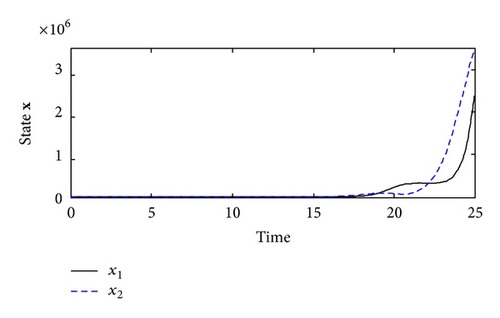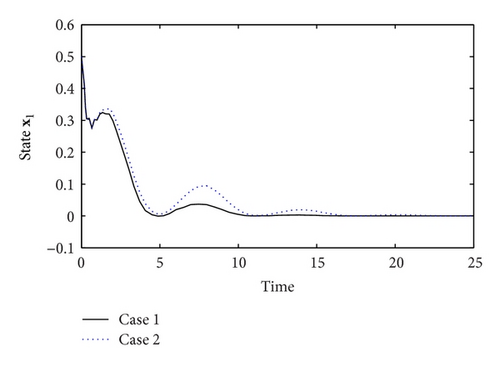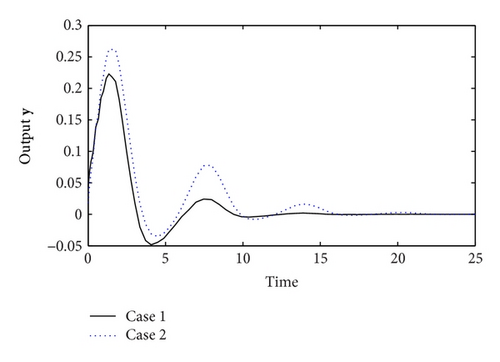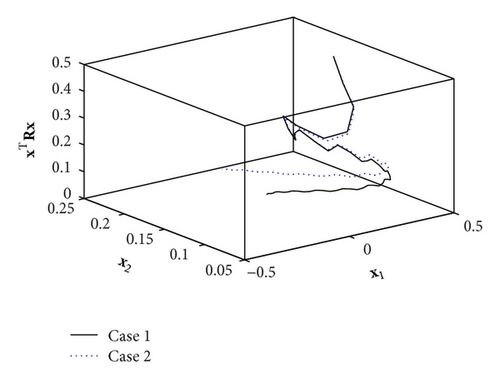Nonfragile Robust Finite-Time L2-L∞ Controller Design for a Class of Uncertain Lipschitz Nonlinear Systems with Time-Delays
Abstract
The nonfragile robust finite-time L2-L∞ control problem for a class of nonlinear uncertain systems with uncertainties and time-delays is considered. The nonlinear parameters are considered to satisfy the Lipschitz conditions and the exogenous disturbances are unknown but energy bounded. By using the Lyapunov function approach, the sufficient condition for the existence of nonfragile robust finite-time L2-L∞ controller is given in terms of linear matrix inequalities (LMIs). The finite-time controller is designed such that the resulting closed-loop system is finite-time bounded for all admissible uncertainties and satisfies the given L2-L∞ control index. Simulation results illustrate the validity of the proposed approach.
1. Introduction
Time-delay is frequently a source of instability and always encounters in various engineering systems such as chemical processes, neural networks, and long transmission lines in pneumatic systems. Recently, many attentions have been paid to the solutions of deal with time-delay which existed in concerned systems, such as the input-output technique [1], delay partitioning method [2], and piecewise analysis method [3]. As an important class of nonlinear systems, the Lipschitzian nonlinear system also has drawn considerable attention in the past few decades. Among these researches, the studies of Lipschitz nonlinear systems with time-delays have received much attention [4–6].
However, it is necessary to point out that the results of the aforementioned papers about time-delayed Lipschitz systems are mostly based on Lyapunov stable theory. As we all known, Lyapunov stable theory pays more attention to the asymptotic pattern of systems over an infinite-time interval. But in some practical process, the main attention may be related to the behavior of the dynamical systems over fixed finite-time interval; for instance, large values of the states cannot be accepted in the presence of saturations. To deal with such situations, Dorato [7] first presented the concept of finite-time stability (or short-time stability) in 1961. In [8], Amato et al. first proposed the concept of finite-time boundedness; thereafter many attempts on finite-time control problems have been made [9–13]. However, to date, little work has been paid attention in finite-time controller design for Lipschitzian nonlinear system. The research topic is still open but challenging. And this is the key motivation of this paper.
On the other hand, in the feedback control schemes, there are often some perturbations appeared in controller gain, which may result from either the actuator degradations or the requirements of readjustment of controller gains during the controller implementation stage. Therefore, it is reasonable that any controller should be able to tolerate some level of controller gain variations, and this motivates many researchers to study the nonfragile controller problems [14–19]. Motivated by the benefits of nonfragile state feedback controller, we consider the nonfragile controller design problem in this paper.
In addition, energy to peak (L2-L∞) control is of a great importance both in control theory and in engineering practice, because of its insensitivity to the exact knowledge of the statistics of the external disturbance signals. In [20], Rotea first introduced the L2-L∞ performance index. After that many researchers have paid attention in L2-L∞ control problems. For example, in [21], the authors studied the L2-L∞ controller design problem for continuous-time multiple delayed linear systems; in [22], the problem of L2-L∞ control for a class of uncertain singular systems with time-delay and norm-bounded parameter uncertainties was investigated by the researchers. For more details of the literatures related to L2-L∞ control schemes, the readers can refer to [21–24] and the references therein.
In short, to the best knowledge of authors, the problem of nonfragile robust finite-time L2-L∞ control for a class of uncertain Lipschitz nonlinear systems with time-delays is not studied at present. This motivates our research.
This paper deals with the problem of nonfragile robust finite-time L2-L∞ control for a class of Lipschitz nonlinear systems with time-delays and uncertainties, and the nonlinear function is assumed to satisfy the Lipschitz conditions. The uncertain parameters are assumed to be time varying and energy bounded. The purpose is to construct a nonfragile state feedback controller such that the resulting closed-loop system is finite-time bounded and satisfies the given L2-L∞ index. By using the Lyapunov function approach and linear matrix inequality techniques, a sufficient condition for the existence of a nonfragile state feedback controller is given and an explicit expression of this controller is presented. Meanwhile, this problem is reduced to an optimization problem under the constraint of LMIs. Finally, a simulation example illustrates the effectiveness of the developed techniques.
The paper is organized as follows. In Section 2, the system description along with necessary assumption is given. Section 3 provides the main results. A simulation example is provided to illustrate the results of the paper in Section 4. Conclusion follows in Section 5.
Notation 1. In the sequel, if not explicitly stated, matrices are assumed to have compatible dimensions. I and 0 represent the identity matrix and a zero matrix. The notation M > (≥, <, ≤) 0 is used to denote a symmetric positive-definite (positive semidefinite, negative-definite, negative semidefinite) matrix. λmin (·), λmax (·) denote the minimum and the maximum eigenvalue of the corresponding matrix, respectively. L2[0 +∞) denotes the Euclidean norm for vectors or the spectral norm of matrices. is the space of n-dimensional square integrable function vector over [0 N]. In symmetric black matrices, we use * that represents the elements below the main diagonal of a symmetric block matrix. The superscript T represents the transpose.
2. Preliminaries and Problem Statement
Remark 1. The parameter uncertainty structure as in (2) and (3) has been widely used in the existing literatures, such as [22, 24, 25]. In many practical applications, the systems parameter uncertainties can be either exactly modeled or overbounded by (3). Note that the unknown matrix function Γ(t) is time-varying, therefore it can be allowed to be state-dependent in some case, that is, Γ(t) = Γ(t, x(t)).
The following preliminary assumptions are made for system (1).
Assumption 1. For any given positive number δ and constant time T, the external disturbances input w(t) is time-varying and satisfies
Assumption 2. is a known nonlinear function which satisfies the following Lipschitz conditions:
- (i)
f(0, 0) = 0;
- (ii)
∥f(x(t), x(t − d))∥ ≤ ∥η1x(t)∥ + ∥η2x(t − d)∥,
Remark 2. The above Lipschitz condition can be considered as an extension of the Lipschitz condition mentioned in [19]. When and , the Lipschitz condition in Assumption 2 will reduce to (4) [19].
Our aim is to develop a nonfragile state feedback controller:
Remark 3. The controller gain perturbations can result from the actuator degradations, as well as from the requirements for readjustment of controller gain during the controller implementation stage. Theses perturbations in the controller gains are modeled here as uncertain gains that are dependent on the uncertain parameters [6]. The models of additive uncertainties and multiplicative uncertainties are used to describe the controller gain variations. For more results on this topic, we refer readers to [6, 17, 18] and the references therein.
By the nonfragile state feedback controller (5), the closed-loop system can be obtained as follows:
To formulate the problem addressed in this paper, we give the following definitions first.
Definition 4 (FTB). For given constants c1 > 0, δ > 0, and T > 0 and a symmetric matrix R > 0, the closed-loop system (7) is said to be robust finite-time bounded (FTB) with respect to (c1 c2 δ T R), if there exists a constant c2 > c1, such that the following relation holds for all the external disturbance w(t):
Remark 5. In fact, if the closed-loop system (7) does not exist the exogenous disturbance input, that is, w(t) = 0, the concept of FTB reduces to finite-time stable (FTS) [8, 11]. That is to say, a system is FTB, if given a bound initial condition and characterization of the set of admissible inputs, then the system states remain below the prescribed limit for all inputs in the bounded set.
Definition 6. The state-feedback controller (5) is said to be a nonfragile robust finite-time L2-L∞ controller with disturbance attenuation γ > 0 for system (1) if the closed-loop system (7) is FTB in the sense of Definition 4, and there exists a positive real constant γ > 0 such that
Furthermore, we introduce the following lemmas which will be used in the development of our main results.
Lemma 7 (see [26].)Let X and Y be real matrices of appropriate dimensions. For any given scalar ε > 0 and vectors x, y ∈ ℜn, then
Lemma 8 (see [27].)Let M and N be real matrices of appropriate dimensions. Then for any matrix F(t) satisfying FΤ(t)F(t) ≤ I and a scalar μ > 0,
3. Main Results
In this section, we will solve the problem of nonfragile robust finite-time L2-L∞ controller design for a class of Lipschitz uncertain nonlinear time-delay systems formulated in the previous section based on LMI approach. The following results actually present the FTB condition for closed-loop system (7) with time-delays.
Theorem 9. For given c1 > 0, δ > 0, T > 0, ε > 0, α > 0 and weighting matrices η1, η2, R > 0, the closed-loop controlled system (7) is FTB with respect to (c1 c2 δ T R), if there exists constant c2 > 0, symmetric positive- definite matrices P and , such that
Proof. Choose a Lyapunov function candidate V(x(t)) as
According to α > 0 and Q > 0, inequality (20) implies J1 < 0. Thus, by using (19), we get
Remark 10. Without the time-delay in the resulted closed-loop system (7), the system will reduce to the system which has been investigated in [25, 28]. In this case, one can get the sufficient conditions of FTB for the aforementioned system from Theorem 9 via a simple transformation. Furthermore, if there is also no nonlinear function in the aforementioned system, then Theorem 9 reduces to a form which has been given in [8, Lemma 6] or [13, Lemma 1].
Theorem 9 gives the sufficient condition of FTB for the resulting closed-loop controlled system (7). Then, we will apply the results in Theorem 11 to solve the problem of nonfragile robust finite-time L2-L∞ controller design.
Theorem 11. For given c1 > 0, δ > 0, T > 0, ε > 0, α > 0, and weighting matrices η1, η2, R > 0, the closed-loop system (7) is FTB with respect to (c1 c2 δ T R) and satisfies the cost function (9) for all admissible w(t) with the constraint condition and all admissible uncertainties, if there exist constants c2 > 0, β > 0, symmetric positive-definite matrices P and , such that conditions (12), (13), and the following inequality hold:
Proof. Defining the same Lyapunov function as Theorem 9. Under the zero initial state condition φ(t) = 0, t ∈ [−d 0], we can rewrite (24) as
Taking the maximum value of , we have with t ∈ [0 T]. Therefore, condition (9) can be guaranteed by letting . This completes the proof.
In order to solve Theorem 11, we can obtain the relevant algorithm by imposing further LMI constraints in the design phase. Substituting the corresponding matrices into matrix inequalities (12), (13), and (28), we can draw the following Theorem 12.
Theorem 12. For given c1 > 0, δ > 0, T > 0, ε > 0, α > 0, and weighting matrices η1, η2, R > 0, the closed-loop system (7) is FTB with respect to (c1 c2 δ T R), exists a nonfragile state-feedback controller gain K = YX−1, and satisfies the cost function (9) for all admissible w(t) with the constraint condition and all admissible uncertainties, if there exist positive constants c2, β, μ1, μ2, μ3, and μ4, symmetric positive- definite matrices X, Q, and Z, and real matrix Y, such that the following LMIs hold:
Proof. In order to deal with the uncertainties in inequality (12), we can rewrite it as the following inequality:
Thus, the aforementioned inequality (38) is equivalent to
Moreover, noticing the uncertainties which were described as the form in (2) and (6), we have
Using Lemma 8, it follows from (41) that
On the other hand, considering the uncertainties in inequality (34), we have
And can be expressed as
Using Lemma 8, we know the following inequality holds by real positive scalars μ3 and μ4:
Define X = P−1, Y = KX, Z = XQX, pre- and postmultiplying inequality (45) by block-diagonal matrix diag {P−1 I I I I I I}, and pre- and postmultiplying inequality (50) by a block-diagonal matrix diag {P−1 I I I}. They lead to LMIs (33) and (34).
Finally, denote , , and set , and consider .
Then, inequality (13) can be guaranteed by
Remark 13. Notice that ; if α and T have been given, the value of system L2-L∞ performance γ only depends on β. Hence, we can obtain an optimal nonfragile robust finite-time L2-L∞ controller, and the scalar β can reduce to the minimum possible value such that LMIs (33)–(37) are satisfied. The optimization problem can be described as follows:
Remark 14. When the controller gain variations of the Lipschitz nonlinear systems (1) are of the multiplicative form [6, 18]:
4. Simulation Example
Remark 16. It is necessary to point out that the selection of the above weighting matrices not only needs to satisfy Assumption 2 but also needs to ensure that the LMI (33) is feasible. Namely, the LMIs designed in this note actually put a constraint on the size of the above weighting matrices.
By resorting to MATLAB LMIs Toolbox, solving Theorem 12 and Remark 13, respectively, we can obtain the following solutions under the above two cases.
Case 1. Let H = [0.3], N = [0.3 0.2], ρ(t) = (0.5/(1 + t2))I, Γ(t) = 0.8sin(t)I. Solving Theorem 12, which considering the additive controller gain variation, we get
Case 2. Let H = [0.3], N = [0.5], ρ(t) = (0.5/(1 + t2))I, and Γ(t) = 0.8sin(t)I. Solving Remark 13, which is considering the multiplicative controller gain variation, we get
The trajectories of uncontrolled system state x(t) are depicted as Figure 1. The states and output simulation curves of closed-loop controlled system are, respectively, shown in Figures 2, 3, and 4 with the simulation time t ∈ [0 25]. Figure 5 shows the evolution of xT(t)Rx(t) (t ∈ [0 4]) of the controlled system (7).





By calculation, we have (Case 1) and (Case 2). According to the above computing results and the simulation results, one can know that the nonfragile state feedback controller which was designed in this note can effectively guarantee that the concerned system (1) not only is finite-time bounded in fixed finite-time interval t ∈ [0 4] but also with an L2-L∞ disturbance performance level.
Remark 17. It should be pointed out that in the simulation example, according to Definition 4, as long as the choice of c1 with the initial states is satisfied to . Then, the nonfragile state feedback controlled system is FTB (i.e., the closed-loop system trajectories stay within a given bound) and satisfies the L2-L∞ constraint condition (9).
5. Conclusions
In this paper, we have studied the nonfragile robust finite-time L2-L∞ control problem for a class of uncertain Lipschitz nonlinear systems with time-delays. By using the Lyapunov function approach and linear matrix inequality techniques, a sufficient condition for the existence of nonfragile robust finite-time L2-L∞ controller has been derived. Based on this condition, an optimization algorithm is provided to find nonfragile optimal control. Finally, a simulation example is presented to illustrate the effectiveness and applicability of the proposed approach.
Acknowledgments
This work was supported in part by the National Natural Science Foundation of China (Grant no. 61203051), the Key Program of Natural Science Foundation of Education Department of Anhui Province (Grant no. KJ2012A014), and the Joint Specialized Research Fund for the Doctoral Program of Higher Education (Grant no. 20123401120010).




